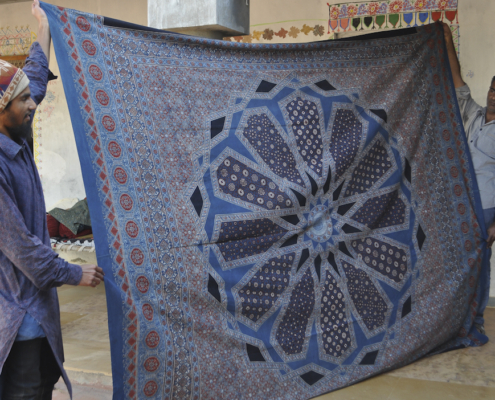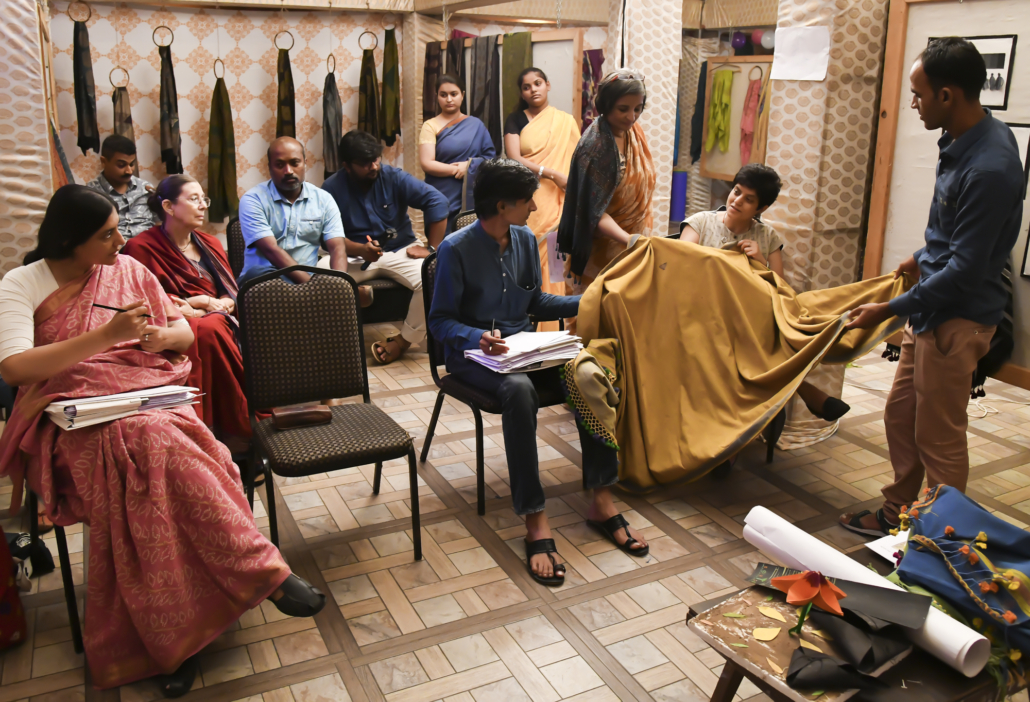The Secret Life of Textiles
 Last summer, we were lucky enough to go to the USA to participate in the Santa Fe International Folk Art Market. Afterwards, we arranged a few opportunities to teach Rabari embroidery to textile enthusiasts in selected American cities.
Last summer, we were lucky enough to go to the USA to participate in the Santa Fe International Folk Art Market. Afterwards, we arranged a few opportunities to teach Rabari embroidery to textile enthusiasts in selected American cities.
In one venue, I was speaking to a former museum colleague who told me she had purchased a de- accessioned museum object from auction. I was surprised, and a little skeptical. Really? Many folk embroideries look similar, after all.
She showed me the piece. I recognized it! It had been published in my book.
It winked at me from her wall. (“Free at last”?)
A moment later, Lachhuben, who had been paging through Threads of Identity while we spoke in a language she could not follow, showed me the frontispiece. “That is my bokani!” she exclaimed.
Though Lachhuben Karna was central to my book, I met this Lachhuben- Lachhuben Raja– only in 1993, well after the book was completed. And, I explained to her, I had bought the bokani from Raniben, Lachhuben Karna’s daughter.
The wheels in Lachhuben Raja’s mind were speeding. “What year was that?” she asked.
1983 or 1984.
Click. “That was the year my husband was working in Muscat,” she said. And then she related how Vanka Kana from Bhujodi, where Raniben and her family lived, had come to her village, Vandh, with a foreign lady and purchased her bokani. It was a dry year, and Rajabhai was away earning. He had not yet sent any money home.
Suddenly I realized what I could never have imagined in 1983. I had asked Raniben for a bokani for the collection I was making. She produced this very nice example, and I happily purchased it from her, diligently taking down the date, her name, the village. In reality the foreign lady had decided against the bokani, Rani had purchased it from Vanka Kana, and sold it to me for a profit! Everyone was happy.
Except maybe Lachhuben Raja. She looked at the piece wistfully. She had made it for her brother, she recalls. But times were tough. And here she was seeing an old friend on the page of a book.
It is only we distant viewers who see these textiles as faceless, examples of traditions. For the people who make and use them, they each are as unique as a child, with as much life force and personality.
And they travel- sometimes great distances- in their lives.
 I remembered this story this month, when Aakib, a very young, talented block print Artisan Designer, sold a masterpiece bed sheet to a foreign visitor. He said it had taken him many months to conceive and produce. I asked how he feels when he sells such a master piece.
I remembered this story this month, when Aakib, a very young, talented block print Artisan Designer, sold a masterpiece bed sheet to a foreign visitor. He said it had taken him many months to conceive and produce. I asked how he feels when he sells such a master piece.
Aakib hesitated, and then shyly said, “When I sell such a piece, I feel I have lost a little something of myself.”



